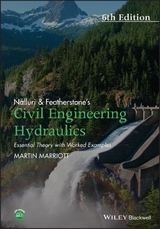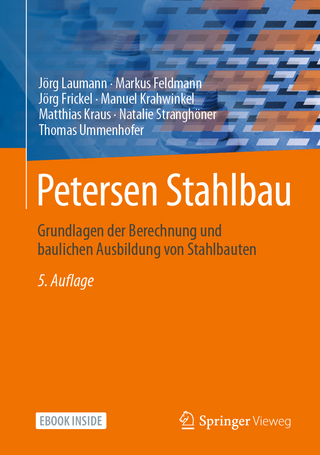
Civil Engineering Hydraulics
Wiley-Blackwell (an imprint of John Wiley & Sons Ltd) (Verlag)
978-1-4051-6195-4 (ISBN)
- Titel ist leider vergriffen;
keine Neuauflage - Artikel merken
Martin Marriott is Principal Lecturer in the School of Computing, Information Technology and Engineering, University of East London. He is a chartered civil engineer, with degrees from the Universities of Cambridge, London (Imperial College) and Hertfordshire. He has wide professional experience in the UK and overseas with major firms of consulting engineers, followed by many years experience as a lecturer in higher education. He is a former Branch Chairman of the Chartered Institution of Water and Environmental Management, and has served as Chief Examiner for the Engineering Council Graduate Diploma paper in Hydraulics and Hydrology.
Preface to Fifth Edition. Preface to Fourth Edition. About the Authors. Symbols. 1 Properties of Fluids. 1.1 Introduction. 1.2 Engineering units 1 1.3 Mass density and specific weight. 1.4 Relative density. 1.5 Viscosity of fluids. 1.6 Compressibility and elasticity of fluids. 1.7 Vapour pressure of liquids. 1.8 Surface tension and capillarity. Worked examples. References and recommended reading. Problems. 2 Fluid Statics. 2.1 Introduction. 2.2 Pascal's law. 2.3 Pressure variation with depth in a static incompressible fluid. 2.4 Pressure measurement. 2.5 Hydrostatic thrust on plane surfaces. 2.6 Pressure diagrams. 2.7 Hydrostatic thrust on curved surfaces. 2.8 Hydrostatic buoyant thrust. 2.9 Stability of floating bodies. 2.10 Determination of metacentre. 2.11 Periodic time of rolling (or oscillation) of a floating body. 2.12 Liquid ballast and the effective metacentric height. 2.13 Relative equilibrium. Worked examples. References and recommended reading. Problems. 3 Fluid Flow Concepts and Measurements. 3.1 Kinematics of fluids. 3.2 Steady and unsteady flows. 3.3 Uniform and non-uniform flows. 3.4 Rotational and irrotational flows. 3.5 One-, two- and three-dimensional flows. 3.6 Streamtube and continuity equation. 3.7 Accelerations of fluid particles. 3.8 Two kinds of fluid flow. 3.9 Dynamics of fluid flow. 3.10 Energy equation for an ideal fluid flow. 3.11 Modified energy equation for real fluid flows. 3.12 Separation and cavitation in fluid flow. 3.13 Impulse-momentum equation. 3.14 Energy losses in sudden transitions. 3.15 Flow measurement through pipes. 3.16 Flow measurement through orifices and mouthpieces. 3.17 Flow measurement in channels. Worked examples. References and recommended reading. Problems. 4 Flow of Incompressible Fluids in Pipelines. 4.1 Resistance in circular pipelines flowing full. 4.2 Resistance to flow in non-circular sections. 4.3 Local losses. Worked examples. References and recommended reading. Problems. 5 Pipe Network Analysis. 5.1 Introduction. 5.2 The head balance method ('loop' method). 5.3 The quantity balance method ('nodal' method). 5.4 The gradient method. Worked examples. References and recommended reading. Problems. 6 Pump-Pipeline System Analysis and Design. 6.1 Introduction. 6.2 Hydraulic gradient in pump-pipeline systems. 6.3 Multiple pump systems. 6.4 Variable-speed pump operation. 6.5 Suction lift limitations. Worked examples. References and recommended reading. Problems. 7 Boundary Layers on Flat Plates and in Ducts. 7.1 Introduction. 7.2 The laminar boundary layer. 7.3 The turbulent boundary layer. 7.4 Combined drag due to both laminar and turbulent boundary layers. 7.5 The displacement thickness. 7.6 Boundary layers in turbulent pipe flow. 7.7 The laminar sub-layer. Worked examples. References and recommended reading. Problems. 8 Steady Flow in Open Channels. 8.1 Introduction. 8.2 Uniform flow resistance. 8.3 Channels of composite roughness. 8.4 Channels of compound section. 8.5 Channel design. 8.6 Uniform flow in part-full circular pipes. 8.7 Steady, rapidly varied channel flow energy principles. 8.8 The momentum equation and the hydraulic jump. 8.9 Steady gradually varied open channel flow. 8.10 Computations of gradually varied flow. 8.11 The direct step method. 8.12 The standard step method. 8.13 Canal delivery problems. 8.14 Culvert flow. 8.15 Spatially varied flow in open channels. Worked examples. References and recommended reading. Problems. 9 Dimensional Analysis, Similitude and Hydraulic Models. 9.1 Introduction. 9.2 Dimensional analysis. 9.3 Physical significance of non-dimensional groups. 9.4 The Buckingham pi theorem. 9.5 Similitude and model studies. Worked examples. References and recommended reading. Problems. 10 Ideal Fluid Flow and Curvilinear Flow. 10.1 Ideal fluid flow. 10.2 Streamlines, the stream function. 10.3 Relationship between discharge and stream function. 10.4 Circulation and the velocity potential function. 10.5 Stream functions for basic flow patterns. 10.6 Combinations of basic flow patterns. 10.7 Pressure at points in the flow field. 10.8 The use of flow nets and numerical methods. 10.9 Curvilinear flow of real fluids. 10.10 Free and forced vortices. Worked examples. References and recommended reading. Problems. 11 Gradually Varied Unsteady Flow from Reservoirs. 11.1 Discharge between reservoirs under varying head. 11.2 Unsteady flow over a spillway. 11.3 Flow establishment. Worked examples. References and recommended reading. Problems. 12 Mass Oscillations and Pressure Transients in Pipelines. 12.1 Mass oscillation in pipe systems - surge chamber operation. 12.2 Solution neglecting tunnel friction and throttle losses for sudden discharge stoppage. 12.3 Solution including tunnel and surge chamber losses for sudden discharge stoppage. 12.4 Finite difference methods in the solution of the surge chamber equations. 12.5 Pressure transients in pipelines (waterhammer). 12.6 The basic differential equations of waterhammer. 12.7 Solutions of the waterhammer equations. 12.8 The Allievi equations. 12.9 Alternative formulation. Worked examples. References and recomended reading. Problems. 13 Unsteady Flow in Channels. 13.1 Introduction. 13.2 Gradually varied unsteady flow. 13.3 Surges in open channels. 13.4 The upstream positive surge. 13.5 The downstream positive surge. 13.6 Negative surge waves. 13.7 The dam break. Worked examples. References and recommended reading. Problems. 14 Uniform Flow in Loose-Boundary Channels. 14.1 Introduction. 14.2 Flow regimes. 14.3 Incipient (threshold) motion. 14.4 Resistance to flow in alluvial (loose-bed) channels. 14.5 Velocity distributions in loose-boundary channels. 14.6 Sediment transport. 14.7 Bed load transport. 14.8 Suspended load transport. 14.9 Total load transport. 14.10 Regime channel design. 14.11 Rigid-bed channels with sediment transport. Worked examples. References and recommended reading. Problems. 15 Hydraulic Structures. 15.1 Introduction. 15.2 Spillways. 15.3 Energy dissipators and downstream scour protection. Worked examples. References and recommended reading. Problems. 16 Environmental Hydraulics and Engineering Hydrology. 16.1 Introduction. 16.2 Analysis of gauged river flow data. 16.3 River Thames discharge data. 16.4 Flood alleviation, sustainability and environmental channels. 16.5 Project appraisal. Worked examples. References and recommended reading. Problems. Answers. Index.
| Erscheint lt. Verlag | 12.6.2009 |
|---|---|
| Zusatzinfo | Illustrations |
| Verlagsort | Chicester |
| Sprache | englisch |
| Maße | 170 x 242 mm |
| Gewicht | 904 g |
| Themenwelt | Technik ► Bauwesen |
| ISBN-10 | 1-4051-6195-7 / 1405161957 |
| ISBN-13 | 978-1-4051-6195-4 / 9781405161954 |
| Zustand | Neuware |
| Haben Sie eine Frage zum Produkt? |
aus dem Bereich



